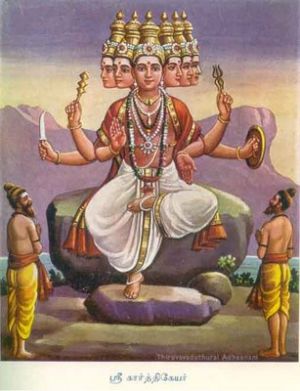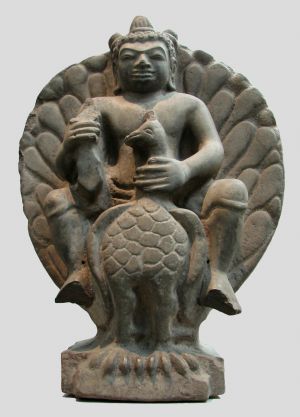Murugan (Tamil: முருகன், Malayalam: മുരുകന്), also called Subrahmanya (Kannada: ಸುಬ್ರಹ್ಮಣ್ಯ,Telugu: సుబ్రహ్మణ్యేశ్వర స్వామి), is a popular Hindu deity Tamil among Tamil Hindus in South India, Singapore, Sri Lanka, Malaysia and Mauritius.
Etymology
Like most Hindu deities, He is known by many other names, including Senthil, Saravaṇa, Kārthikeya (meaning 'son of Krittika' ), Arumugam or Sanmuga (meaning 'one with six faces'), Kumāra (meaning 'child or son'), Guhan (meaning 'cave-dweller'), Skanda (meaning 'that which is spilled or oozed, namely seed' in Sanskrit), Subrahmaṇya, Vēlaṇ and Swaminatha and called as Kadamban in Melakadambur, means "who wearing Kadambu flowers in his shoulders"
Origin
Given that legends related to Murugan are recounted separately in several Hindu epics, some differences between the various versions are observed. Some Sanskrit epics and puranas indicate that he was the elder son of Shiva. This is suggested by the legend connected to his birth; the wedding of Shiva and Parvati being necessary for the birth of a child who would vanquish the demon Taraka. Also, Kartikeya is seen helping Shiva fight the newborn Ganesha, Shiva's other son, in the Shiva Purana. In the Ganapati Khandam of the Brahma Vaivarta Purana, he is seen as the elder son of Shiva and Ganesha as the younger. In South India, it is believed that he is the younger of the two. A Puranic story has Ganesha obtain a divine mango of knowledge from Narada winning a contest with Murugan. While Murugan speeds around the world thrice to win the contest for the mango, Ganesha circumambulates Shiva and Parvati thrice as an equivalent and is given the mango. After winning it, he offers to give the mango to his upset brother. After this event, Ganesha was considered the elder brother owing as a tribute to his wisdom.
In many traditions, Murugan is seen as a bachelor. Many of the major events in Murugan's life take place during his youth, and legends surrounding his birth are popular. This has encouraged the worship of Murugan as a child-God, very similar to the worship of the child Krishna in north India. Other traditions have him married to two wives, Valli and Deivayanai.
Appearance
Kartikeya symbols are based on the weapons - Vel, the Divine Spear or Lance that He carries and His mount the peacock. He is sometimes depicted with many weapons including: a sword, a javelin, a mace, a discus and a bow although more usually he is depicted wielding a sakti or spear. This symbolizes His purification of human ills. His javelin is used to symbolize His far reaching protection, His discus symbolizes His knowledge of the truth, His mace represents His strength and His bow shows His ability to defeat all ills. His peacock mount symbolizes his destruction of the ego.
His six heads represent the six siddhis bestowed upon yogis over the course of their spiritual development. This corresponds to his role as the bestower of siddhis.
Legends
Sanskrit literature
The references to Murugan in Sanskrit literature can be traced back to the first millennium BCE. There are references to Subrahmanya in Kautilya's Arthashastra, in the works of Patanjali, in Kalidasa's epic poem the Kumarasambhavam and in the Sanskrit drama Mricchakatika. The Kushanas, who governed from what is today Peshawar, and the Yaudheyas, a republican clan in the Punjab, struck coins bearing the image of Skanda. The deity was venerated also by the Ikshvakus, an Andhra dynasty, and the Guptas. The worship of Kumāra was one of the six principal sects of Hinduism at the time of Adi Shankara. The Shanmata system propagated by him included this sect. In many Shiva and Devi temples of Tamil Nadu, Subrahmaṇya is installed on the left of the main deity.
Sati, the consort of Shiva immolated herself at the Daksha Yagna, which was later destroyed by Shiva. Sati was reborn as Uma, or Parvati the daughter of the mountain king Himavaan (the Himalayas). Shiva withdrew himself from the universe and engaged himself in yogic meditation in the Himalayas.
In the meanwhile, the demon Surapadman ravaged the earth and tormented its beings. It was realized by the gods that only the son born of Shiva could lead the gods to victory over Tarakasuran, Surapadman and their demon companions. They plotted with Kamadeva, to shoot a flower arrow at Shiva, as he sat in meditation, so as to make him fall in love with Parvati. When Kama aimed his arrow, Shiva opened his third eye and burned Kama to ashes instantly.
The sparks of the fiery seed of Shiva were unbearable; even the fire God Agni could not bear them; this fire was then transported by the river Ganga into the Saravana forest into a pond called the Saravana Poigai(located at mouths of river Ganga), where the sparks became six children. They were raised by the six Krittika or Kartika - the stars that make up the Pleiades, earning the name Karthikeya. Parvati combined these six babies into one with six faces, i.e. Shanmukha or Arumugan. Since he was born in the Saravana he was also called 'Saravanabhava'.
Murugan became the supreme general of the demi-gods then escorted the devas and led the army of the devas to victory against the demons. The six sites at which Karthikeya sojourned while leading his armies against Surapadman are Tiruttanikai, Swamimalai, Tiruvavinankudi (Palani), Pazhamudirsolai, Tirupparamkunram and Tiruchendur. All these sites have ancient temples glorified by the Tamil poems of Tirumurugaatruppadai of the Sangam period (circa the 3rd century AD).And these six sites collectively came to be known as "Arupadai Veedu" (Lang:Tamil), it means the six battle camps of the Lord.
Hindu epics
The first elaborate account of Karthikeya's origin occurs in the Mahabharata. In a complicated story, he is said to have been born from Agni and Shiva, after the latter impersonated the six of the seven wives of the Saptarishi (Seven Sages). The actual wives then become the Pleiades. Karthikeya is said to have been born to destroy the Asura Mahisha. (In later mythology, Mahisha became the adversary of Durga.) Indra attacks Karthikeya as he sees the latter as a threat, until Shiva intervenes and makes Karthikeya the commander-in-chief of the army of the Devas. He is also married to Devasena, Indra's daughter. The origin of this marriage lies probably in the punning of 'Deva-sena-pati'.It can mean either lord of Devasena or Lord of the army(sena) of Devas.
The Ramayana version is closer to the stories told in the Puranas discussed below.
Vedas
The Atharva Veda describes Kumaran as 'Agnibhuh' or son of Agni, the fire god. The Satapatha Brahmana refers to him as the son of Rudra and the ninth form of Agni. The Taittiriya Aranyaka contains the Gayatri mantra for Shanmukha. The Chandogya Upanishad refers to Skanda as the "way that leads to wisdom". The Baudhayana Dharmasutra mentions Skanda as 'Mahasena' and 'Subrahmanya.' The Aranya Parva canto of the Mahabharata relates the legend of Kartikeya Skanda in considerable detail. The Skanda Purana is devoted to the narrative of Kartikeya.
Puranas
Though slightly varying versions occur in the Puranas, they broadly follow the same pattern. By this period, the identification of Shiva/Rudra with Agni, that can be traced back to the Vedas and Brahmanas, had clearly made Karthikeya the son of Shiva.
The Skanda Purana narrates that Shiva first wed Dakshayani (also named Sati), the granddaughter of Brahma, and the daughter of Daksha. Daksha never liked Shiva, who, symbolizing destruction and detachment, begs for food, dances in a graveyard smeared with ashes, and has no possessions, not even good clothes for himself. Daksha publicly insults Shiva in a Yagna ceremony, and Dakshayani immolates herself. The Yagna is destroyed although protected by all the other Gods and the rishis. Taraka believed that, because Shiva is an ascetic and his earlier marriage was conducted with great difficulty, his remarriage was out of the question, hence his boon of being killed by Shiva's son alone would give him invincibility.
The Devas manage to get Shiva married to Parvati (who was Dakshayani, reborn), by making Manmatha (also known as Kama), the God of love awaken him from his penance, but Manmatha incurred the Lord's wrath indicated by the opening his third eye - "Netri Kann" , and being destroyed and resurrected. Shiva hands over his effulgence of the third eye used to destroy Manmatha to Agni, as he alone is capable of handling it until it becomes the desired offspring. But even Agni, tortured by its heat, hands it over to Ganga who in turn deposits it in a lake in a forest of reeds (shara).
The child is finally born in this forest (vana) with six faces-eesanam, sathpurusham, vamadevam, agoram, sathyojatham and adhomugam. He is first spotted and cared for by six women representing the Pleiades - Kritika in Sanskrit. He thus gets named Karthikeya. As a young lad, he destroys Taraka. He is also called Kumara (Sanskrit for "youth").
Temples
- The main temples of Murugan are located in Southern Tamil Nadu. They include the Aru Padaiveedu (six houses- rather, military camps in his campaign against demons) - Thiruchendur, Swamimalai, Pazhamudircholai, Thirupparangunram, Palani (Pazhani), Thiruthani - and other important shrines like Mayilam, Sikkal, Marudamalai, Kundrathur, Vadapalani, Kandakottam,Thiruporur, Vallakottai, Vayalur, Thirumalaikoil, Vella Kovil, Kukke Subramanya. Malai Mandir, a prominent and popular temple complex in Delhi, is one of the few dedicated to Murugan in all of North India apart from the famous Pehowa temple in Haryana.
- There are innumerable temples dedicated to Lord Subramanya in Kerala. Amongst them , the most important ones are Payyannur Subrahmanya Swamy temple in Payyanur and the Subramanya temple in Haripad.
- In Tulu Nadu there is the famed temple called Kukke Subramanya Temple. Here Lord Murugan is worshipped as the Lord of the serpents.
- The key temples in Sri Lanka include the sylvan shrine in Kataragama / (Kadirgamam), or Kathirkamam in the deep south, the temple in Tirukovil in the east, the shrine in Embekke in the Kandyan region and the famed Nallur Kandaswamy temple in Jaffna.
- There are several temples dedicated to Lord Murugan in Malaysia, the most famous being the Batu Caves near Kuala Lumpur. There is a 42.7m high statue of Lord Murugan at the entrance to the Batu Caves, which is the largest Lord Murugan statue in the world.
- Sri Thendayuthapani Temple in Tank Road, Singapore is a major Hindu temple where each year the Thaipusam festival takes place with devotees of Lord Muruga carrying Kavadis seeking penance and blessings of the Lord.
External links
- http://www.palanitemples.com/ Lord Muruga Portal
- Murugan Bhakti Website
- Subrahmanya Swami Temple of Payyanur
- http://www.highgatehillmurugan.org/
- http://www.leicestersrimurugantemple.org.uk/ Leicester Sri Siva Murugan Temple Official Website
- Swami Sivananda's book on Lord Kartikeya; also available on PDF.
- Skanda worship in Katirkamam, Sri Lanka
- Kaumaram Murugan Info
- YouTube video lectures praising Lord Muruga and explaining Kandhar Anubudhi by the "YouTube Pugal Muruga Bhaktan"
- Murugan devotional video songs - YouTube Playlist
- Murugan Temple in D.D.O., Montreal, Canada


